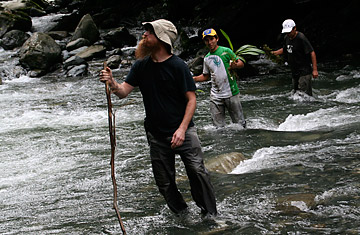
Botanist John Janovec (left) of the Botanical Research Institute of Texas scans a river bank for new species, as he, Jefferson Ballón (center) and William Nauray return from an orchid-collecting expedition in the cloud forest near Quincemil, Peru.
A sure way to get people riled up in Quince Mil, a sweltering outpost in Peru's southern jungle, is to ask about the origin of the town's uncommon name. There are at least four versions explaining the name, which means "Fifteen Thousand," each more colorful than the one before it. Mayor Mario Samanez claims to have the official version. He says its rains around 15,000 mm (590 inches) each year in the town, hence the name. "This is the spot with the world's second highest amount of rainfall annually. That is where the name comes from," Samanez says.
Actually the U.S. National Oceanic and Atmospheric Administration does not list Quince Mil among the wettest places in the world. The title goes to Mawsynram, India, with 467 inches, followed by jungle spots in Colombia and Hawaii.
Local residents in Quince Mil have their own theories about the name. Some say a group of explorers passing through lost 15,000 pesos where the town now stands. The place was called 15,000 because that's what the explorers would ask for every time they came back to search for the cash. The town's name has become a synonym for bad luck. But malevolence may be at the origin as well. Fernando Farro, a local farmer, says Quince Mil takes its name from the amount of money the Peruvian government gave Russian fortune-seekers at the turn of the 20th century to eliminate Amazonian tribes and open the area for sugar plantations. And that darker explanation may be more relevant now as more and more attention is being paid to the backwater town.
Quince Mil sits at a strategic point on one of the final legs of a new highway that will link Peru's Pacific coast to Sao Paulo on Brazil's southern Atlantic coast. A few years ago it would take a week to get from Cuzco, in the Andes, to Quince Mil, with the road reaching elevations of 14,000 feet and descending fast into thick, tropical forest. The same route, now being paved by a Brazilian construction company, will take around six hours when the road is finished. "The road means radical change for the population. It is a great opportunity for people throughout the valley to get their products to markets," says Samanez, who expects the blacktop to finally reach the town in mid-2010.
José Bonifaz, an economist at Peru's University of the Pacific, calculates in a new book that the road will generate close to $2 billion for local communities in the coming two decades. The government forecasts that the highway could add a full percentage point to GDP. Brazil will be the big beneficiary at the start, sending minerals, meat and soybeans through Peru for export to China, instead of using the Panama Canal. But local authorities expect the Peruvian entreprenerus to slowly catch up with exports headed across the Atlantic.
Quince Mil is doing its part to get ready. The number of boarding houses — mainly rooms crafted of plywood and plastic sheets — has jumped from two to more than 30 and the residents say there has been an explosion in restaurants, bars and small shops as folks get ready for the highway, instead of dirt road, traffic. The population has more than doubled since the last census in 2007, when there were fewer than 1,000 people in the town.
While pleased with the highway, Samanez is worried that it could spark the destruction of the area's pristine forests because of gold found in rivers. There are already more than 100 requests for mining concessions around Quince Mil (five have been formally granted) and with gold prices above $1,000 an ounce a gold rush is already on in the nearby Madre de Dios state. Samanez is hoping the state creates a protected in nearby forests that would curb mining, logging and cattle farming.
U.S. scientists working in the zone share Samanez's concern and believe that Quince Mil could be put on the map for its environmental potential. "This is a biological hotspot. There is so much out there just waiting to be identified," says John Janovec, a botanist from the Botanical Research Institute of Texas. He sees tourists coming down to gawk at birds, tropical flowers and brilliantly colored butterflies.
Janovec, who looks more like a ZZ Top guitarist than an expert on the nutmeg tree, is constantly darting about as he coordinates the Andes to Amazon Biodiversity Project that has documented new species of bugs, birds and plants. He has a revolving door program that continuously brings in other specialists. In early November he was sharing Quince Mil with Russ Van Horn, a leading expert in bears from the San Diego Zoo, and Eric Christenson, a renowned botanist from Florida specializing in orchids.
Their days begin at 4 a.m. and extend late into the night. Christenson has already identified orchids not known to exist in Peru and Van Horn is setting dozens of camera traps to document nocturnal animal activity. Most of the work is done to the constant sound of rain on the tin roof and with spotty electricity, as the town's small electricity generator is constantly on the fritz. "The development here has been incredible. Things are moving so quickly it is hard to know if Quince Mil will still be surrounded by forests in a few years," says Van Horn.
